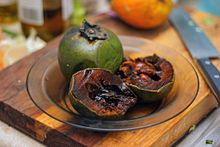Sapote
 | |
| Type | Fruit |
|---|---|
| Region or state | Mexico, Central America and northern parts of South America |
Sapote (/səˈpoʊtiː, -eɪ, -ə/;[1][2][3] from Nahuatl: tzapotl[4]) is a term for a soft, edible fruit.[1] The word is incorporated into the common names of several unrelated fruit-bearing plants native to Mexico, Central America and northern parts of South America.[1][5] It is also known in Caribbean English as soapapple.[citation needed]
-
Casimiroa edulis, white sapote
-
Quararibea cordata, South American sapote
-
Pouteria sapota, mamey sapote
-
Manilkara zapota, sapodilla
-
Pouteria campechiana, yellow sapote
Sapotaceae
Some but not all sapotes come from the family Sapotaceae:
- Sapodilla,[3][4] also called naseberry (Manilkara zapota) is native to Mexico, Guatemala, Nicaragua, Belize, and possibly El Salvador. The Sapotaceae were named after a synonym of this species.
- Yellow sapote (Pouteria campechiana) is native to Mexico and Central America.
- Mamey sapote (Pouteria sapota)[1][2] is from southern Mexico to northern South America.
- Green sapote (Pouteria viridis) is native to lowland southern Mexico.
Other sapote
- Black sapote (Diospyros nigra: Ebenaceae),[1] from eastern Mexico south to Colombia, is probably the original Aztec tzapotl.
- White sapote (Casimiroa edulis: Rutaceae)[1] is native to northern and central Mexico, Costa Rica, El Salvador and Guatemala.[6]
- South American sapote (Quararibea cordata: Malvaceae)[5] is native to the Amazon rainforests of Brazil, Colombia, Ecuador, and Peru.
- Sun sapote (Licania platypus: Chrysobalanaceae) is native to southern Mexico south to Colombia.
See also
- Chapote (Diospyros texana: Ebenaceae) is native to the lower Rio Grande valley region in Texas and Mexico
References
- ^ a b c d e f "sapote". Merriam-Webster.com Dictionary. Retrieved 2024-03-26.
- ^ a b "sapote". WordReference.com Dictionary of English. Retrieved 26 March 2024.
- ^ a b "sapote". Oxford English Dictionary (Online ed.). Oxford University Press. doi:10.1093/OED/3396265629. Retrieved 2024-03-26. (Subscription or participating institution membership required.)
- ^ a b Watson, George (April 1938). "Nahuatl Words in American English". American Speech. 13 (2): 113–114. doi:10.2307/451954. JSTOR 451954.
tropical evergreen tree Achras sapota [...] sapote [...] derivative from Nahuatl tzapotl. The Spanish diminutive form gave English sapodilla in the same sense
- ^ a b Morton, Julia F. (1987). Chupa-Chupa. Miami, FL. p. 291–292. ISBN 978-1626549722. Retrieved 26 March 2024 – via Purdue University Horticulture & Landscape Architecture.
{{cite book}}: CS1 maint: location missing publisher (link) - ^ "Casimiroa edulis". Germplasm Resources Information Network. Agricultural Research Service, United States Department of Agriculture. Retrieved 2009-03-26.



![Manilkara zapota, Hồng xiêm, a kind of Vietnamese sapote[citation needed]](http://upload.wikimedia.org/wikipedia/commons/thumb/e/ed/Vietnamese_Sapote.JPG/120px-Vietnamese_Sapote.JPG)


